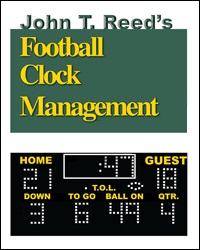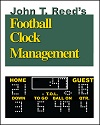

 | $39.95 |
Purchased by the Bills, Colts, Cowboys, Eagles, 49ers and Titans, as featured in the 1/26/09 issue of ESPN magazine ("3-2-1...MELTDOWN")
ESPN Magazine - There's plenty of help out there if teams want it. John T. Reed, a Harvard MBA, Northern California real estate guru and former high school football coach, is the author of Football Clock Management, 280 pages of graphs and charts explaining how to handle time better. The book is also loaded with oft-forgotten mantras like "Every second you leave on the clock unnecessarily may be the one your opponent uses to beat you."
‘That was really good!’ - Bill Walsh
6/1/04—John T. Reed had just delivered a clinic speech on Football Clock Management to a select group of prominent minority coordinators at NCAA headquarters in Indianapolis. Bill Walsh, sitting in the front row after his lecture on the passing game, stood up and made that comment to Reed. Walsh seemed surprised at how much he had learned from the talk. When Reed asked Walsh for advice on how to make the talk better, Walsh added, “You’re the man on clock management. Act like it.”
“It is a magnificently thorough treatment of the subject and is worthwhile reading for every coach and aspiring coach. It must have been fun to research and write it.” Marv Levy, Hall of Fame NFL coach
Play-by-play analysis of the clock management of the Patriots-Giants Super Bowl by John T. Reed
Think you know how to manage the clock?
You be the coach and make the call on 3 scenarios to test your knowledge. CLICK HERE for the answer
Scenario 1
With college or NFL rules, you're winning 14-13, 1:32 left in the game, 3rd and Goal on your opponents 4 yard line, and they have no timeouts left. You run a play-action pass, touchdown. Flag on the play, pass interference on the defense.
Do you accept or decline the penalty? CLICK HERE
 Accept the penalty.
Accept the penalty. Many coaches say never to take points off the board. They are
wrong in this case. You take points off the board if it puts you in the take-a-knee period. You're guaranteed to win, whereas declining the penalty and kicking the extra pt gives your opponent 1:30 to score 8 pts. In 2007 when pass interference meant an automatic first down at all levels, a high school coach declined the penalty in this exact situation and lost the game in overtime as a result. By doing that, the coach violated my Clock Management Rule 1.20(v). He also violated my general principle of more versus enough. That is, you never ever seek more points, first downs, or yards after you have enough to win the game. All that coach had to do was accept the penalty and take a knee four times and he would have won.
Scenario 2
You're losing 14-13, and you have one timeout left, the opponent has the ball on their own 30, 1:50 left in the game, 3rd and 10. You need to force a punt and get into field goal range.
Do you save your timeout to get the field goal team on the field? CLICK HERE for the answer
 Absolutely not.
Absolutely not. Using timeouts on defense saves about 40 seconds per timeout. If you use them on offense, when you are in your hurry up, they only save about 12 seconds per timeout. There are other ways to stop the clock like spiking the ball, throwing an incomplete pass or running out of bounds. You can also kick a field goal without stopping the clock if there are more than about 14 seconds on the game clock. This is covered by my Clock Management Rule 4.00(h).
Scenario 3
NFL: You're winning 17-14 with possession of the ball. Your opponent has two timeouts, and you get a first down at the 50 yard line with 1:36 left, staying in bounds so they call a timeout (1 remaining).
Do you need to get another first down or can you take a knee to run out the clock? CLICK HERE for the answer
 Neither
Neither. You are
not in the take-a-knee period, but you
are in the quarterback-sweep-slide period. The take-a-knee play only takes about two seconds. You should make it take longer if you can. Adding the sweep slide adds about four seconds in the NFL; more in high school and college where they do not start the play clock until they move the ball back to the hash and get the officials ready for the next play. Your quarterback runs the sweep slide to wide side of the field each play, losing 15 yards each time, making sure to stay
in bounds. If you have not entered the take-a-knee period by 3rd down (40 seconds with no timeouts) on about your own 20, run the sweep slide again. If your quarterback is able to avoid sliding until the clock drops below 40 seconds, you have won and can walk off the field. If he slides with 40 or more seconds left, you will have to run one more, where he will stay inbounds until the horn and then step out the back of the end zone. There will be no time left, and you win 17-16 despite the intentional safety.
“Every coach should read this book.”Hal Mumme, Head Football Coach, University of Kentucky


“I know that [our head] Coach Miriello meant it when he said, ‘Football Clock Management is the best football coaching book I have ever read.’” Gene McCabe, Running Backs Coach, Washington and Lee University, Lexington, VA
Football Clock Management, 4th edition is a 298-page, 8 1/2 x 11, paperback book by John T. Reed. It covers the clock-management aspects of offense, defense, and special teams. $39.95 plus CA residents pay sales tax.
 Accept the penalty. Many coaches say never to take points off the board. They are wrong in this case. You take points off the board if it puts you in the take-a-knee period. You're guaranteed to win, whereas declining the penalty and kicking the extra pt gives your opponent 1:30 to score 8 pts. In 2007 when pass interference meant an automatic first down at all levels, a high school coach declined the penalty in this exact situation and lost the game in overtime as a result. By doing that, the coach violated my Clock Management Rule 1.20(v). He also violated my general principle of more versus enough. That is, you never ever seek more points, first downs, or yards after you have enough to win the game. All that coach had to do was accept the penalty and take a knee four times and he would have won.
Accept the penalty. Many coaches say never to take points off the board. They are wrong in this case. You take points off the board if it puts you in the take-a-knee period. You're guaranteed to win, whereas declining the penalty and kicking the extra pt gives your opponent 1:30 to score 8 pts. In 2007 when pass interference meant an automatic first down at all levels, a high school coach declined the penalty in this exact situation and lost the game in overtime as a result. By doing that, the coach violated my Clock Management Rule 1.20(v). He also violated my general principle of more versus enough. That is, you never ever seek more points, first downs, or yards after you have enough to win the game. All that coach had to do was accept the penalty and take a knee four times and he would have won.  Absolutely not. Using timeouts on defense saves about 40 seconds per timeout. If you use them on offense, when you are in your hurry up, they only save about 12 seconds per timeout. There are other ways to stop the clock like spiking the ball, throwing an incomplete pass or running out of bounds. You can also kick a field goal without stopping the clock if there are more than about 14 seconds on the game clock. This is covered by my Clock Management Rule 4.00(h).
Absolutely not. Using timeouts on defense saves about 40 seconds per timeout. If you use them on offense, when you are in your hurry up, they only save about 12 seconds per timeout. There are other ways to stop the clock like spiking the ball, throwing an incomplete pass or running out of bounds. You can also kick a field goal without stopping the clock if there are more than about 14 seconds on the game clock. This is covered by my Clock Management Rule 4.00(h). Neither. You are not in the take-a-knee period, but you are in the quarterback-sweep-slide period. The take-a-knee play only takes about two seconds. You should make it take longer if you can. Adding the sweep slide adds about four seconds in the NFL; more in high school and college where they do not start the play clock until they move the ball back to the hash and get the officials ready for the next play. Your quarterback runs the sweep slide to wide side of the field each play, losing 15 yards each time, making sure to stay in bounds. If you have not entered the take-a-knee period by 3rd down (40 seconds with no timeouts) on about your own 20, run the sweep slide again. If your quarterback is able to avoid sliding until the clock drops below 40 seconds, you have won and can walk off the field. If he slides with 40 or more seconds left, you will have to run one more, where he will stay inbounds until the horn and then step out the back of the end zone. There will be no time left, and you win 17-16 despite the intentional safety.
Neither. You are not in the take-a-knee period, but you are in the quarterback-sweep-slide period. The take-a-knee play only takes about two seconds. You should make it take longer if you can. Adding the sweep slide adds about four seconds in the NFL; more in high school and college where they do not start the play clock until they move the ball back to the hash and get the officials ready for the next play. Your quarterback runs the sweep slide to wide side of the field each play, losing 15 yards each time, making sure to stay in bounds. If you have not entered the take-a-knee period by 3rd down (40 seconds with no timeouts) on about your own 20, run the sweep slide again. If your quarterback is able to avoid sliding until the clock drops below 40 seconds, you have won and can walk off the field. If he slides with 40 or more seconds left, you will have to run one more, where he will stay inbounds until the horn and then step out the back of the end zone. There will be no time left, and you win 17-16 despite the intentional safety.

